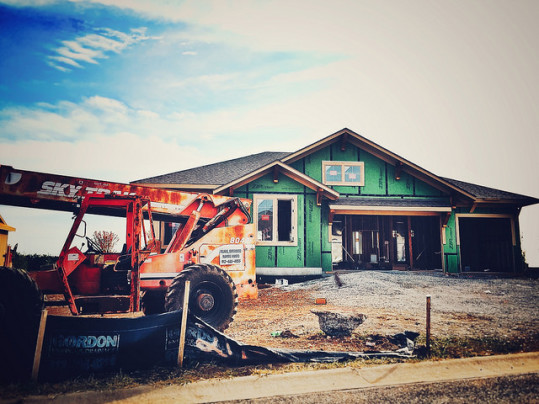The National Association of Realtors’ Pending Home Sales Index measures the number of contracts to buy homes that were signed during the month. Because it measures signings and not closings, the index is considered a good indication of what home sales will do in the coming months. In September, pending home sales fell 2.3 percent. It was the second straight month contract signings declined. Lawrence Yun, NAR’s chief economist, said there are many reasons contributing to September’s dip in activity. “There continues to be a dearth of available listings in the lower end of the market for first-time buyers, and Realtors in many areas are reporting stronger competition than what’s normal this time of year because of stubbornly low inventory conditions,” Yun said. “Additionally, the rockiness in the financial markets at the end of the summer and signs of a slowing U.S. economy may be causing some prospective buyers to take a wait-and-see approach.” But despite slowing sales and low inventory levels, the number of contracts signed in September was still 3 percent above last year’s level and pending sales have now increased year-over-year for 13 straight months. And, according to Yun, housing demand should remain strong for the foreseeable future due, in part, to lower-than-normal mortgage rates, rents near 8-year highs, and continuing gains in the job market. More here.
Archive for October 2015
Mortgage Rate Increase Slows Demand
According to the Mortgage Bankers Association’s Weekly Applications Survey, average mortgage rates rose last week from the week before. Rates were up across all loan categories, including 30-year fixed-rate mortgages with both conforming and jumbo balances, loans backed by the Federal Housing Administration, and 15-year fixed-rate loans. The increase had a negative effect on mortgage application demand, despite the fact that rates were up only slightly from the previous week and remain near historic lows. In fact, the Market Composite Index – which measures both refinance and purchase activity – was down 3.5 percent, led by a 4 percent drop in the Refinance Index. The good news, according to MBA chief economist Michael Fratantoni, is that recent volatility appears to be settling down. “Between the recent TILA-RESPA regulatory change and the Columbus Day holiday, mortgage application volume has been more volatile than normal,” Fratantoni said. “However, that appears to be settling down somewhat.” Also in the report, demand for loans to purchase homes was 23 percent higher than it was during the same week last year. The MBA’s weekly survey has been conducted since 1990 and covers 75 percent of all retail residential mortgage applications. More here.
Real Estate Rebound Continues On Track
Freddie Mac’s Multi-Indicator Market Index measures the real estate recovery by comparing current data to long-term norms in local markets across the country. The index tracks home purchase application data, payment-to-income ratios, proportion of on-time mortgage payments, and the local job market in all 50 states and the top 100 metropolitan markets. According to the most recent results, the housing market’s rebound is on track and has entered the outer range of stable housing activity. In fact, 29 of 50 states are now in a stable range, along with 47 percent of the top metro areas. Freddie Mac’s deputy chief economist, Len Kiefer, says housing markets across the country are getting back to their long-term benchmark averages. “The nation’s housing market continues to improve, riding the wave of the best year in home sales since 2007,” Kiefer said. “With the MiMi purchase applications indicator at its highest level in more than seven years, we expect home sales to remain strong. Low mortgage rates are fueling the recovery across the country. Places like Denver, Austin, and Salt Lake City, and most markets in California, are seeing robust home purchase demand and, in many cases, double-digit growth over last year.” Despite the rosy outlook, however, Kiefer also cautions that there’s still room for improvement and income growth will have to be stronger to sustain the gains throughout 2016. More here.
New Homes Sell At A Slower Pace In September
Sales of newly built single-family homes slowed in September after two consecutive months of improvement. The decline was expected and, though larger than previously forecast, economists believe it only represents a temporary setback. That’s because most other recent real estate data shows an improving market and rising optimism. In fact, September sales of previously owned homes were at their second highest pace since 2007 and both builder confidence and housing starts have showed recent improvement. In addition, because there are fewer new homes available for sale, new home sales tend to be more volatile than other sales data. That means, month-over-month results may find dramatic ups and downs but taking a longer view provides perspective. For example, sales dropped 11.5 percent in September, led by a 61.8 percent decrease in the Northeast. But, despite the decline, total sales are still up 2 percent from one year ago. Overall, the housing market continues to make gains and is now helping build household wealth, which is boosting consumer spending and contributing to the broader economy. More here.
As Buyers Get Older, Homes Get Bigger
Recent real estate data shows a lot of positive momentum in the housing market. Builder confidence just reached a 10-year high, construction of new homes is beginning to ramp up and, in August, new home sales hit their highest level since 2008. But, though residential real estate appears to be returning to pre-recession levels and is now a bright spot in the larger economic picture, a closer look at the numbers reveals today’s typical home buyer and the size of the average home have changed. For example, the median age of today’s home buyer is 43. That’s four years older than the median in 2005 and nearly 10 years older than it was in 1985. Skylar Olsen, senior economist at Zillow, told CNN, buying a home later in life is part of a larger change in American life. “We consistently tell that story of people delaying homeownership,” Olsen said. “People are delaying things that pre-date homeownership – like getting married later and having children later.” Because the median home buyer is older, the typical home has changed as well. Mostly they’ve gotten bigger. New homes today are typically around 2,200 square feet and have more bathrooms than homes did in years past. Just 15 years ago, the typical home was 1,800 square feet. More here.
Existing Home Sales Rebound In September
After slowing in August, sales of previously owned homes rebounded in September, according to the National Association of Realtors. Existing home sales – which include single-family homes, townhomes, condominiums, and co-ops – increased 4.7 percent from the month before and are now 8.8 percent above last year’s pace. Lawrence Yun, NAR’s chief economist, said moderating home prices and still-low mortgage rates are keeping demand strong. “September home sales bounced back solidly after slowing in August and are now at their second highest pace since February 2007,” Yun said. “While current price growth around 6 percent is still roughly double the pace of wages, affordability has slightly improved since the spring and is helping to keep demand at a strong and sustained pace.” In fact, prices rose year-over-year for the 43rd consecutive month in September. But, while price increases are driven, in part, by a lower-than-normal number of homes available for sale, they also lead to increasing equity for current homeowners. And, as equity has improved, more current homeowners have been motivated to put their homes up for sale. This is helping to moderate price increases, in addition to boosting inventory and the number of trade-up buyers active in the market. More here.
Average Mortgage Rates Fell Last Week
According to the Mortgage Bankers Association’s Weekly Applications Survey, average mortgage rates for 30-year fixed-rate mortgages with both conforming and jumbo balances, as well as loans backed by the Federal Housing Administration, fell last week from the week before. Rates are now at their lowest level since spring. The drop in rates – along with the continuing volatility caused by newly implemented industry regulations – caused a spike in mortgage application demand. In fact, the seasonally adjusted purchase index increased 16 percent from one week earlier and refinance activity was up 9 percent. “On an adjusted basis, application volume increased last week, led by a sharp rebound in government volume,” Mike Fratantoni, MBA’s chief economist, said. “We expect that application volume will remain volatile over the next few weeks as the industry continues to implement TILA-RESPA integrated disclosures.” The spike in purchase applications – which are a good indicator of future home sales – puts purchase demand 9 percent higher than the same week one year ago. The MBA’s weekly survey has been conducted since 1990 and covers 75 percent of all retail residential mortgage applications. More here.







